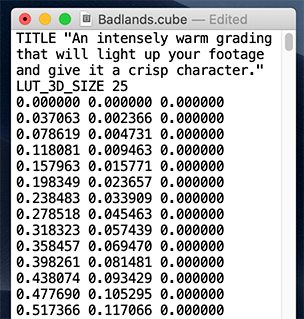Tip #1367: When to Use, or NOT Use, a LUT
… for Visual Effects
Tip #1367: When to Use, or NOT Use, a LUT
Larry Jordan – LarryJordan.com
A LUT is a look-up table. Ideal for on-set use, more limited in post.


This article, written by Charles Haine, first appeared in NoFilmSchool.com. This is a summary.
A LUT is just a “lookup table.” That’s it. It’s a table of values. In fact, if you have a LUT of some sort, you can open that LUT in TextEdit or Notepad and read it. (See screen shot)
Every LUT format spells out what those numbers mean. So each number in the table refers to a specific color value in your image, and the numbers in the table tell the system how to change it. Make it brighter, make it darker, make it bluer, redder, greener.
You can think of a LUT as being a bit like a filter that changes what your footage looks like.
You’ll see a lot about 1D and 3D LUTs, and once you know the difference, it’s easy to remember.
A 1D LUT only covers one direction, brightness. So you’ll often see 1D LUTs used for converting log to linear footage, since that is a transformation of brightness.
A 3D LUT covers 3 dimensions, which are the red, green, and blue channels of color video. If you want to change the color of something, you’ll need a 3D LUT. Of course, brightness can be changed with a 3D LUT, but not as precisely and the files are bigger, so 1D LUTs remain popular for what they are used for.
Some might hear this and think, “Oh, a LUT is just a look!” And in some ways, a LUT and a “look” are somewhat similar. …A LUT can’t do sharpness. So it’s important to remember that a LUT and a look are different, with a LUT being a simple file designed for contrast, brightness, and color cast changes, while a “look” refers to all the things affecting the personality or vibe of an image.
First and foremost, it’s that a LUT affects your whole image the same way. You can’t apply any shape information on a LUT, so you can’t do a subtle vignette to point the eye or do anything else with shapes. A LUT affects every pixel in the frame the same way.
On top of that, LUTs have some technical issues that come from bit depth and banding. Because the file sizes of LUTs are small, you sometimes run into an issue where fine detail in a gradient comes in between steps in the table. This leads to an output that looks banded.
LUTs are best avoided as part of the final creative color grading process. When you get into your grading session, you might bring along your LUTs to show them to the colorist to help give them perspective on the looks you were using while shooting and editing, but it’s better for the colorist to recreate that look from scratch in their editing platform than to work with the LUT on.
Because of banding and gamut issues, LUTs can get in the way of taking full advantage of everything available to you in a final grade.
While LUTs are wonderful and are likely here to stay on set, they are slowly being moved out of post. The replacement is what is called a transform. Transforms are incredibly powerful because they don’t have the banding and gamut issues of LUTs. Since it’s math, there is no “out of gamut” error caused by the transform. It can always calculate a new value.


Hi Larry,
I didn’t know about LUT’s and banding issues either.
When you talk about transforms are we talking about ACES workflow.
Unfortunately not many colourists or DoP’s I know use or know much about this workflow.
Yet I believe it is a far superior and archival workflow we should all be looking into and adopting.
Con.
Con:
A “transform” is simply a conversion from one color description (a LUT) to another.
ACES includes transforms, but it encompasses far more than that. I agree, it is a significant workflow, but not all software supports it, nor are many of us trained in how to use it.
Larry
Larry, thank you for this concise explanation of LUTs versus looks. I was most intrigued to hear about a 3D LUT’s limitations regarding banding, and how a professional colorist will “start from scratch” recreating the visual look the director or DP is going for. I have argued with a friend who thinks that LUTs have too many variables for an individual colorist or editor to re-do themselves. Finally, the idea of transforms sounds most intriguing, since it bypasses the banding potential of LUTs. I want to know more about the software that makes transforms possible. I sometimes use 709 LUTs in editing S-Log footage, but I can’t help from feeling that they are a blunt instrument.
Brian:
Indeed, I found this article fascinating as well.
I don’t have recommendations for transform software, however. I’m still learning about this process.
Larry